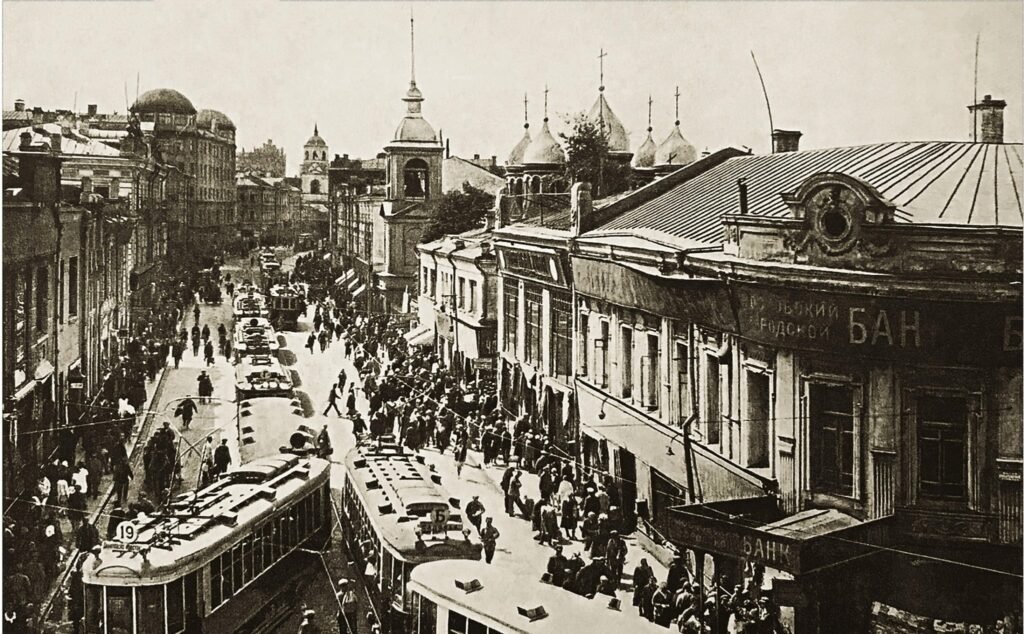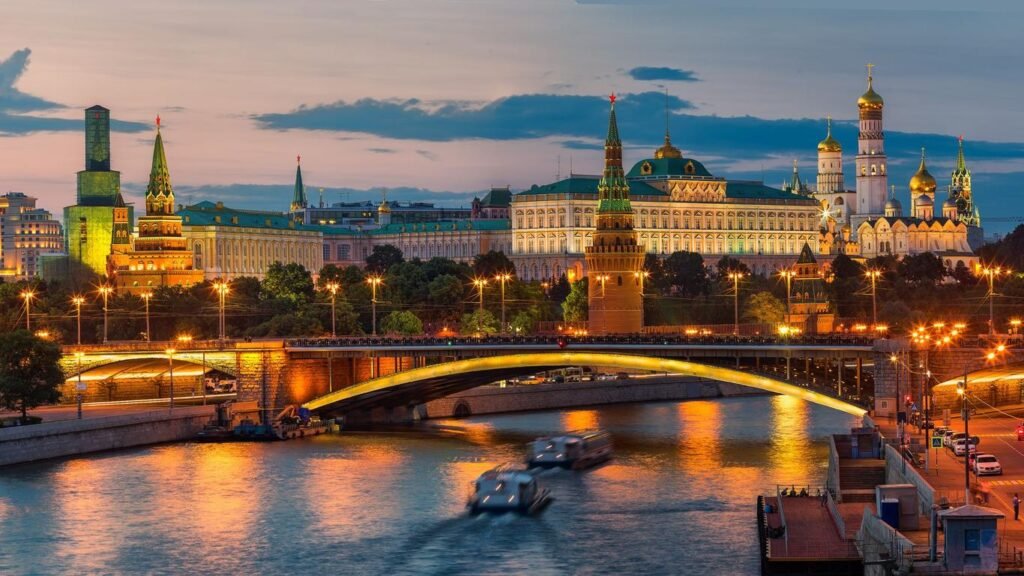Moscow Then and Now
Moscow Then
Moscow, the capital city of Russia, is situated in the far western part of the country and serves as its political, cultural, and economic center.
The city’s name is believed to be derived from the Moskva River, though there are various theories regarding the river’s name.
Moscow is often referred to as “The Third Rome,” reflecting its historical and spiritual significance in Russia, and it is one of the twelve Hero Cities in recognition of its resilience during times of war.
A resident of Moscow is called a Muscovite, and the city has earned a reputation for being the heart of Russia, in contrast to St. Petersburg, which is known as the country’s “window on Europe.”
Moscow is a dynamic, fast-paced city that combines the modern vibrancy of a global metropolis with a rich history.

Much of the city had to be rebuilt after the 1812 French occupation by Napoleon, during which the city was almost completely destroyed by fire.
Despite the challenges it has faced, Moscow has emerged as a symbol of endurance and cultural strength, showcasing both old-world charm and modernity.
Related Article: Warsaw Then and Now
Moscow History
The early history of Moscow reflects a city shaped by strategic growth, fortified defenses, and significant cultural and political shifts.
From its earliest Neolithic inhabitants, the area evolved into a small town in the 12th century before becoming a dominant force in Russian history.
Moscow’s development accelerated under the leadership of the Rurikid princes, notably Daniel, who in the late 13th century began expanding Moscow’s influence.
Related Article: Budapest Then and Now
Daniel’s establishment of monasteries and his role in local power struggles laid the groundwork for Moscow’s rise.
By the early 14th century, under Ivan I, the city became a hub of economic and political power, positioning itself as the center of the Vladimir-Suzdal principality.
The city’s importance grew, especially after the Mongol invasion, which saw its destruction and later rise as a critical base against Mongol dominance.
Related Article: Prague Then and Now

Ivan III’s reign in the late 15th century marked Moscow’s transition to the capital of a burgeoning empire.
Moscow faced challenges in the 16th and 17th centuries, including invasions, internal uprisings, and plagues, but continued to grow.
The city underwent significant fortifications and urban planning during this period, including the addition of ramparts and defensive walls.
Related Article: Vienna Then and Now
Despite invasions like the Crimean Tatar raids and the Polish-Lithuanian occupation in the early 17th century, Moscow rebuilt itself, and the Romanov dynasty’s rise in 1613 secured its future.
The city’s transformation continued into the 18th and 19th centuries, particularly under the reign of Peter the Great, who relocated the Russian capital to St. Petersburg but did not diminish Moscow’s significance.
Rebuilding efforts after Napoleon’s invasion in 1812 led to the creation of iconic landmarks, including the Grand Kremlin Palace and Bolshoi Theatre.
Related Article: Athens Then and Now
In the 19th century, Moscow saw industrialization and urbanization, with the introduction of public parks, rail stations, and city planning innovations like the grid system of streets and modernized infrastructure.
By the early 20th century, Moscow had firmly established itself as the heart of Russian political, cultural, and industrial life.
Despite setbacks, such as fires, invasions, and plagues, it continued to evolve and expand, leading to the massive cityscape that stands today.
Related Article: Rome Then and Now
Moscow Now

Moscow, the capital and largest city of Russia, stands as one of the most influential urban centers in the world.
Situated on the banks of the Moskva River in Central Russia, it is a city of remarkable size and cultural significance.
With a population surpassing 13 million within its city limits, and over 21 million residents in its metropolitan area, Moscow is the most populous city in Europe and one of the largest cities globally.
Related Article: Barcelona Then and Now
Its vast expanse covers 2,511 square kilometers within the city itself, while the urban area extends over 5,891 square kilometers, making it the largest city by land area on the European continent.
The city’s influence stretches far beyond its borders, contributing significantly to the political, cultural, and economic landscape of Russia and the world.
One of Moscow’s defining features is its rich architectural heritage, which is evident in landmarks such as the Red Square, the iconic Saint Basil’s Cathedral, and the Moscow Kremlin.
Related Article: Amsterdam Then and Now
The Kremlin, a UNESCO World Heritage Site, serves as the seat of the Russian government, symbolizing the nation’s long history and political power.
Moscow is home to a blend of historic and modern architecture, with palaces, cathedrals, and contemporary skyscrapers coexisting in a cityscape that reflects Russia’s evolution.
The city’s well-preserved historical sites draw millions of visitors annually, further cementing Moscow’s status as a cultural hub.
Related Article: Berlin Then and Now
In addition to its architectural landmarks, Moscow’s infrastructure is highly developed, offering a comprehensive transit network that includes four international airports, ten railway terminals, and an extensive metro system.
The Moscow Metro, known for its ornate stations and efficiency, is the busiest metro system in Europe and one of the largest in the world.
The city’s public transport network ensures that residents and visitors can easily navigate Moscow’s vast territory, which spans over 39 kilometers from west to east and 51 kilometers from north to south.
Related Article: Paris Then and Now
Moscow’s metro, trams, buses, and monorails provide seamless connectivity across the city and its surrounding areas.
Moscow is also recognized for its green spaces, with over 40 percent of the city’s territory covered by greenery, which includes parks, gardens, and wooded areas.
This makes the city one of the greenest in the world, offering residents and tourists alike a balance of urban life and natural beauty.
Related Article: London Then and Now
The city’s location along the Moskva River adds to its scenic appeal, with numerous bridges and canals enhancing the picturesque landscape.
The river, which spans over 500 kilometers through Central Russia, is a key feature of the city’s geography, with 49 bridges crossing it within Moscow’s limits.
Moscow’s climate and topography also play a role in shaping the city’s character.
Related Article: Phnom Penh Then and Now
The city sits at an elevation of 156 meters above sea level at the All-Russia Exhibition Center, with Teplostan Upland being the highest point in the city at 255 meters.
The varying elevation of the city, combined with its geographical location, influences its weather patterns and contributes to the region’s temperate continental climate.
Related Article: Kathmandu Then and Now
In conclusion, Moscow is a city of contrasts, where historic landmarks, modern infrastructure, and abundant green spaces coexist to create a dynamic and vibrant urban environment.
Its rich cultural heritage, political significance, and impressive urban design make it not only the heart of Russia but also a key global city.
Related Article: Colombo Then and Now
FAQs
Moscow is famous for being Russia’s political, cultural, and economic center. It is known for its iconic landmarks, such as the Kremlin, Red Square, and Saint Basil’s Cathedral, as well as its rich history, vibrant arts scene, and global influence.
Moscow is located in Europe. While Russia spans both Europe and Asia, Moscow is situated in the European part of Russia, along the Moskva River.
Moscow can be expensive, particularly in terms of housing, dining, and entertainment, especially in central areas.
However, the cost of living can vary depending on lifestyle and location within the city.
Moscow is beautiful due to its blend of historic architecture, such as the Kremlin and Saint Basil’s Cathedral, alongside modern skyscrapers.
The city’s green spaces, parks, and the scenic Moskva River also add to its charm, creating a harmonious mix of nature and urban life.






























